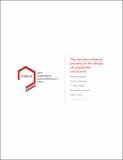| dc.contributor.author | Ghattas, Randa | |
| dc.contributor.author | Gregory, Jeremy | |
| dc.contributor.author | Miller, T. Reed | |
| dc.contributor.author | Kirchain, Randolph | |
| dc.date.accessioned | 2016-11-14T19:30:11Z | |
| dc.date.available | 2016-11-14T19:30:11Z | |
| dc.date.issued | 2015-03 | |
| dc.identifier.uri | http://hdl.handle.net/1721.1/105322 | |
| dc.description.abstract | Building codes and standards have been key drivers in shifting industry towards more energy efficiency, but it is important to take a more holistic approach toward GHG mitigation and evaluate the impact of design decisions from construction, through operation, maintenance, repair and replacement, and end of life. MIT CSHub researchers surveyed architectural firms, homebuilders and developers to understand what decisions are made at different points in the design process so that tools can be targeted accordingly. | en_US |
| dc.description.sponsorship | This research was carried out by the CSHub@MIT with sponsorship provided by the Portland Cement Association (PCA) and the Ready Mixed Concrete (RMC) Research & Education Foundation. | en_US |
| dc.language.iso | en_US | en_US |
| dc.publisher | MIT Concrete Sustainability Hub | en_US |
| dc.subject | Residential Buildings | en_US |
| dc.subject | Residential Construction | en_US |
| dc.subject | Building Energy Consumption | en_US |
| dc.subject | Architecture | en_US |
| dc.subject | Greenhouse Gas | en_US |
| dc.subject | Life Cycle Assessment | en_US |
| dc.subject | Life Cycle Cost Analysis | en_US |
| dc.title | The decision-making process in the design of residential structures | en_US |
| dc.type | Technical Report | en_US |
